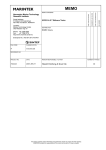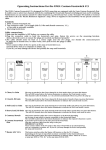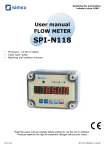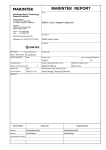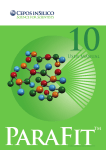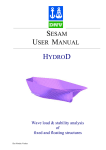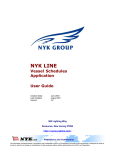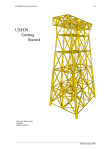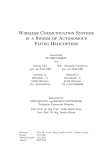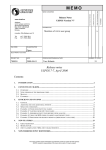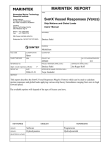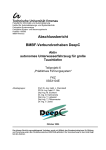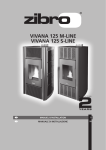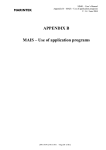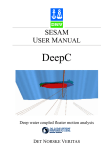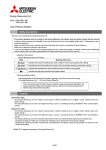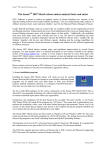Download RIFLEX-3.6.6 Release notes
Transcript
Phone: +47 7359 5500 Fax: +47 7359 5776 http://www.marintek.sintef.no AS AGREED Location: Marine Technology Centre Otto Nielsens veg 10 RIFLEX 3.6.6 RELEASE NOTES COMMENTS ARE INVITED Postal address: P.O.Box 4125 Valentinlyst NO-7450 Trondheim, NORWAY FOR YOUR ATTENTION MEMO CONCERNS Norwegian Marine Technology Research Institute FOR YOUR INFORMATION MEMO | DISTRIBUTION RIFLEX users Enterprise No.: NO 937 357 370 MVA PROJECT NO. DATE PERSON RESPONSIBLE / AUTHOR 519619 2009-03-18 Harald Ormberg / Elizabeth Passano NUMBER OF PAGES 9 Table of contents 1 RIFLEX 3.6 releases .............................................................................................................. 2 1.1 RIFLEX 3.6.0 ................................................................................................................... 2 1.2 RIFLEX 3.6.1 ................................................................................................................... 2 1.3 RIFLEX 3.6.2 ................................................................................................................... 2 1.4 RIFLEX 3.6.3 ................................................................................................................... 2 1.5 RIFLEX 3.6.4 ................................................................................................................... 2 1.6 RIFLEX 3.6.5 ................................................................................................................... 2 1.7 RIFLEX 3.6.6 ................................................................................................................... 2 2 RIFLEX version number ...................................................................................................... 3 3 RIFLEX 3.6 license management system ............................................................................ 3 4 Work array size and maximum number of arrays on file ................................................. 3 4.1 Work array size in STAMOD .......................................................................................... 3 4.2 Work array size in DYNMOD ......................................................................................... 3 4.3 Work array size in OUTMOD.......................................................................................... 3 4.4 Maximum number of arrays stored on file <prefix>_ifnsta.ffi ........................................ 4 4.5 Maximum number of arrays stored on file <prefix>_ifndyn.ffi....................................... 4 4.6 Maximum number of arrays stored on file <prefix>_ifnirr.ffi ......................................... 4 5 Input file changes ................................................................................................................... 5 6 Error corrections and improvements................................................................................... 6 6.1 Corrections and improvements included in RIFLEX 3.6.1.............................................. 6 6.2 Corrections and improvements included in RIFLEX 3.6.3.............................................. 6 6.3 Corrections and improvements included in RIFLEX 3.6.5.............................................. 6 6.4 Corrections and improvements included in RIFLEX 3.6.6.............................................. 7 7 New/improved functionality in RIFLEX 3.6 .......................................................................8 8 Removed functionality in RIFLEX 3.6 ................................................................................9 This memo contains project information and preliminary results as a basis for final report(s). MARINTEK accepts no responsibility of this memo and no part of it may be copied. RIFLEX-3.6.6 Release notes 1 project no: date: page 519619 2009-03-18 2 of 9 RIFLEX 3.6 releases 1.1 RIFLEX 3.6.0 Released 08-05-27. Initial release of RIFLEX 3.6 1.2 RIFLEX 3.6.1 Released 08-08-28. Error corrections and improvements 1.3 RIFLEX 3.6.2 Released 08-09-22. First 3.6 release of VIVANA 1.4 RIFLEX 3.6.3 Released 08-10-21. Error corrections. 1.5 RIFLEX 3.6.4 Released 08-11-05. Error corrections concerning coupled analysis (SIMO) and VIVANA. Initial release / coordination with release of DeepC (2008) 1.6 RIFLEX 3.6.5 Released 08-11-25. Error corrections. New analysis option. 1.7 RIFLEX 3.6.6 Released 09-03-18. Minor error corrections and also error corrections concerning coupled analysis (SIMO) and VIVANA. For coupled analysis, please confer SIMO3.6.5 release notes. K:\RIFLEX\Release\Relnotes\release-3.6\RIFLEX-ReleaseNotes-366.doc RIFLEX-3.6.6 Release notes 2 project no: date: page 519619 2009-03-18 3 of 9 RIFLEX version number RIFLEX 3.6 is the new official version of RIFLEX replacing RIFLEX 3.4 that was initially released in March 2005. The sub-version number is added to track corrections made to the version. Subsequent (bug fix) releases will be labelled 3.6.1, 3.6.2, etc. The odd numbered versions, e.g. 3.5, 3.7 etc., are reserved for internal development versions. The next official release will therefore be RIFLEX 3.8. 3 RIFLEX 3.6 license management system RIFLEX v3.6 is license-managed using the FLEXlm software license management system from Globetrotter Software. If you want RIFLEX to be usable from any networked computer on your site you must run a license manager on a server in your network. In order to issue license keys for this license manager, MARINTEK needs the following info on your server: Hostname and IP address Operating system and version (Win2k/WinXP, HP-UX, Linux and SGI supported) FLEXlm hostID Utilities to generate the FLEXlm hostID and FLEXlm End Users Guide can be downloaded from: http://www.macrovision.com/ Utilities and manual are also included on your distribution media. Your IT-staff is probably already familiar with this procedure as FLEXlm is used by a large number of other applications (e.g. Matlab). If you have any questions, please contact RIFLEX support ([email protected]) 4 Work array size and maximum number of arrays on file 4.1 Work array size in STAMOD The size of the STAMOD work arrays may be specified using the environment variable RIFLEX_STAMOD_MEM The variables give the size in MB, i.e. 4 times the number of million words. The minimum size is 1 MB and the maximum size is 800 MB. The default size of the STAMOD work array is 4 million words. This corresponds to specifying 16 MB. 4.2 Work array size in DYNMOD The size of the DYNMOD work arrays may be specified using the environment variable RIFLEX_DYNMOD_MEM The variables give the size in MB, i.e. 4 times the number of million words. The minimum size is 1 MB and the maximum size is 800 MB. The default size of the DYNMOD work array is 8 million words. This corresponds to specifying 32 MB. 4.3 Work array size in OUTMOD The size of the OUTMOD work arrays may be specified using the environment variable K:\RIFLEX\Release\Relnotes\release-3.6\RIFLEX-ReleaseNotes-366.doc RIFLEX-3.6.6 Release notes project no: date: page 519619 2009-03-18 4 of 9 RIFLEX_OUTMOD_MEM The variables give the size in MB, i.e. 4 times the number of million words. The minimum size is 1 MB and the maximum size is 800 MB. The default size of the OUTMOD work array is 8 million words. This corresponds to specifying 32 MB. 4.4 Maximum number of arrays stored on file <prefix>_ifnsta.ffi The maximum number of arrays to be stored in the file <prefix>_ifnsta.ffi may be specified using the environment variable RIFLEX_MAXSTA_IFNSTA The minimum number is 2,000 and the maximum number is 2 millions. The default value is 20,000. 4.5 Maximum number of arrays stored on file <prefix>_ifndyn.ffi The maximum number of arrays to be stored in the file <prefix>_ifndyn.ffi may be specified using the environment variable RIFLEX_MAXDYN_IFNDYN The minimum number is 50,000 and the maximum number is 2 millions. The default value is 200,000. 4.6 Maximum number of arrays stored on file <prefix>_ifnirr.ffi The maximum number of arrays to be stored in the file <prefix>_ifnirr.ffi may be specified using the environment variable RIFLEX_MAXIRR_IFNIRR The minimum number is 100 and the maximum number is 100,000. The default value is 2,000. K:\RIFLEX\Release\Relnotes\release-3.6\RIFLEX-ReleaseNotes-366.doc RIFLEX-3.6.6 Release notes 5 project no: date: page 519619 2009-03-18 5 of 9 Input file changes INPMOD External and internal contact radius are new input parameters that applies for the component types: CRS0 and CRS1 STAMOD: Data group C1: Parameter variation definition The data group C1.2: Number of variations and variation code has been modified from NSTVAR IOFPOS ICUVAR IFOVAR MAXIPV RACUPV LOTYP1 LOTYP2 NBOUND to NSTVAR IOFPOS ICUVAR IFOVAR MAXIPV RACUPV LOTYP1-4 (NBOUND) DYNMOD: Data group E15 The data group identifier E 15.1: SYSTEM CONDITION STORAGE has been replaced by STORE VISUALISATION RESPONSES K:\RIFLEX\Release\Relnotes\release-3.6\RIFLEX-ReleaseNotes-366.doc RIFLEX-3.6.6 Release notes 6 project no: date: page 519619 2009-03-18 6 of 9 Error corrections and improvements 6.1 Corrections and improvements included in RIFLEX 3.6.1 Results to ascii or binary file (DYNMOD) CRS0: In case of kinematic/isotropic hardening the stored results were for the previous iteration step. CRS3: non-dimensional hydrodynamic coefficients The specified non-dimensional hydrodynamic coefficients were taken as dimensional coefficients. Enforce nodal base vector system to be orthonormal The requirement to orthonormality has been made stricter. This may give insignificant changes to results. Coupled analysis (STAMOD) The computed stiffness contributions from “SIMO” forces were erroneous. This could cause the static solution to diverge. Normally this gave insignificant changes to the static equilibrium configuration if the solution was found. Flex-joint The applied flex-joint stiffness was erroneous when tabulated moment/rotation relation was specified. Error in stiffness for dofs subsequent to the first dof with tabulated stiffness. 6.2 Corrections and improvements included in RIFLEX 3.6.3 Contact forces/boundary change and use of sparse matrix formulation (DYNMOD) This error concerns the options: Elastic contact surface, Pipe-in-pipe contact and Boundary change including winching. The structural velocity and acceleration may be inconsistent when the contact changes from one node to another (system dependent). The error appears as a transient that damps out. The error has been present in all previous versions of RIFLEX. The error has been corrected Boundary change during static parameter variation (STAMOD) Error preventing boundary change during parameter variation has been corrected. Error since RIFLEX 3.6.0 Skew boundary conditions Error in skew boundary conditions, including vessel boundary conditions. If skew boundary is specified, the error leads to erroneous results. Error since RIFLEX 3.6.0. Angle between local vessel axis and an element running regular wave analysis (OUTMOD) The computed time series of the relative angle between local vessel axis and an element has been correct. Error since RIFLEX 3.2. 6.3 Corrections and improvements included in RIFLEX 3.6.5 Rigid supernode connection (DYNMOD) Error in nonlinear dynamic analysis when rigid connections are specified. This is almost always the case running coupled analysis. Error since RIFLEX 3.6.3 Slug effect analysis (DYNMOD) Slug effect analysis is made available for AR-systems. This option requires that a main riser line has been defined. K:\RIFLEX\Release\Relnotes\release-3.6\RIFLEX-ReleaseNotes-366.doc RIFLEX-3.6.6 Release notes project no: date: page 519619 2009-03-18 7 of 9 6.4 Corrections and improvements included in RIFLEX 3.6.6 Rigid node connection (STAMOD) A 3 dof “slave” node with prescribed or “fixed” master node did not correctly follow the rotations of the master node during the loading for displacements (DISP). Correct in parameter variation or and dynamic analysis. The error has been corrected Global springs and dampers The results from linearized time domain analysis involving global springs and dampers were erroneous. The error has been corrected. Error since RIFLEX 3.6.0. Global springs and dampers are now correctly echoed on the _stamod.res file. Coupled analysis For coupled analysis, please confer SIMO-3.6.5 release notes. K:\RIFLEX\Release\Relnotes\release-3.6\RIFLEX-ReleaseNotes-366.doc RIFLEX-3.6.6 Release notes 7 project no: date: page New/improved functionality in RIFLEX 3.6 Tubular contact component (new) The component is available in connection with elastic contact surface description. Winch specification (new) This option enables the user to model winching of single lines. Double peaked Torsethaugen 5.4 – C14 5.3 – B8 5.3 – B9 5.5 – D4 wave spectrum (new) Global springs The formulation has been extended to include non-linear spring characteristics and dash pot damping. 5.4 – C6 Pipe-in-pipe contact formulation (new) This option enables the user to model pipe-in-pipe contact effects where each of the pipes is defined as a single line. user manual section ref. Flex-joint connector (new) This component can be used to model ball joints, hinges and universal joints with specified rotational stiffness. In the present version, flex-joint connectors may only be used in nonlinear static and dynamic analysis. 519619 2009-03-18 8 of 9 Seafloor contact 1. Include friction contact to torsional loading 2. Include damping contribution 3. Allow for sparse matrix formulation in combination with 3D-seafloor 5.3 – B6.8 5.3 – B3.2 5.3 – B6.3 All items above apply for IBTANG =-1 or IBOT3D = 1 Floater force model (Coupled analysis) All modelling functionalities and load models provided by the computer program SIMO are available in coupled analysis. Exceptions are hydrodynamic coupling/interaction and SIMO body types 2 and 4. Diffracted wave kinematics (new) The load effect due to diffracted wave kinematics has been improved and reimplemented. The option is available for irregular wave analysis only. 7.5 – D3.1 Static equilibrium computation (FEM) The formulation used during 1st load group has been made more numerically robust. This may give insignificant changes to the results 5.7 Element memory for kinematic / isotropic hardening (CRS0/CRS1) Activation of the element memory may be specified during any load group or parameter variation during static analysis. The memory effect will always be active during non-linear dynamic analysis. K:\RIFLEX\Release\Relnotes\release-3.6\RIFLEX-ReleaseNotes-366.doc 6.3 – B6 6.3 – B7.1 6.4 – C1.2 RIFLEX-3.6.6 Release notes project no: date: page Velocity and acceleration of “slave” dofs (rigid node connection) The velocity and acceleration computations for “slave” dofs have been modified to be in accordance with the Newmark-beta relation. This may give small changes to results. 519619 2009-03-18 9 of 9 5.3 – B6.10 Contact springs (Linearized dynamic analysis) Apply spring stiffness for all nodes in contact the seafloor even if the nodal status is sliding from static analysis. This may give small changes to results. Export static results for visualization by SIMVIS Specifying export of element responses enables visualization of the incremental loading configurations by the computer program SIMVIS after completion of the static analysis. In the case of an error termination, results from all iteration during the last load step are also exported. 6.2 - A4 PLOMOD The number of environmental variables needed by PLOMOD has been reduced to two; RIFLEX_HOME and GPGS_DEVICES. If the environmental variable RIFLEX_PLO_INCA is not set, PLOMOD will search for the Inca command file plomod.inca on the $RIFLEX_HOME\etc catalogue. If the command file is not found, PLOMOD will prompt the user to specify the file. If the environmental variable RIFLEX_PLO_LOGO is not set, PLOMOD will search for the logo file $RIFLEX_HOME\etc\logo.dat. If no logo file is found, the logo will be set to MARINTEK. The logo file is an ASCII text file containing up to ten letters (A-Z) which will be written in the lower left corner of the plots. If necessary, the logo will be scaled to fit the available space. 8 Removed functionality in RIFLEX 3.6 1. The coupled riser systems CA and CB are not available for modelling purposes. Coupled riser systems may be modelled using an arbitrary (AR) system. (Input to INPMOD) 2. The possibility to model several riser systems in one INPMOD input file has been the removed. The INPMOD input file may only contain one riser system K:\RIFLEX\Release\Relnotes\release-3.6\RIFLEX-ReleaseNotes-366.doc









